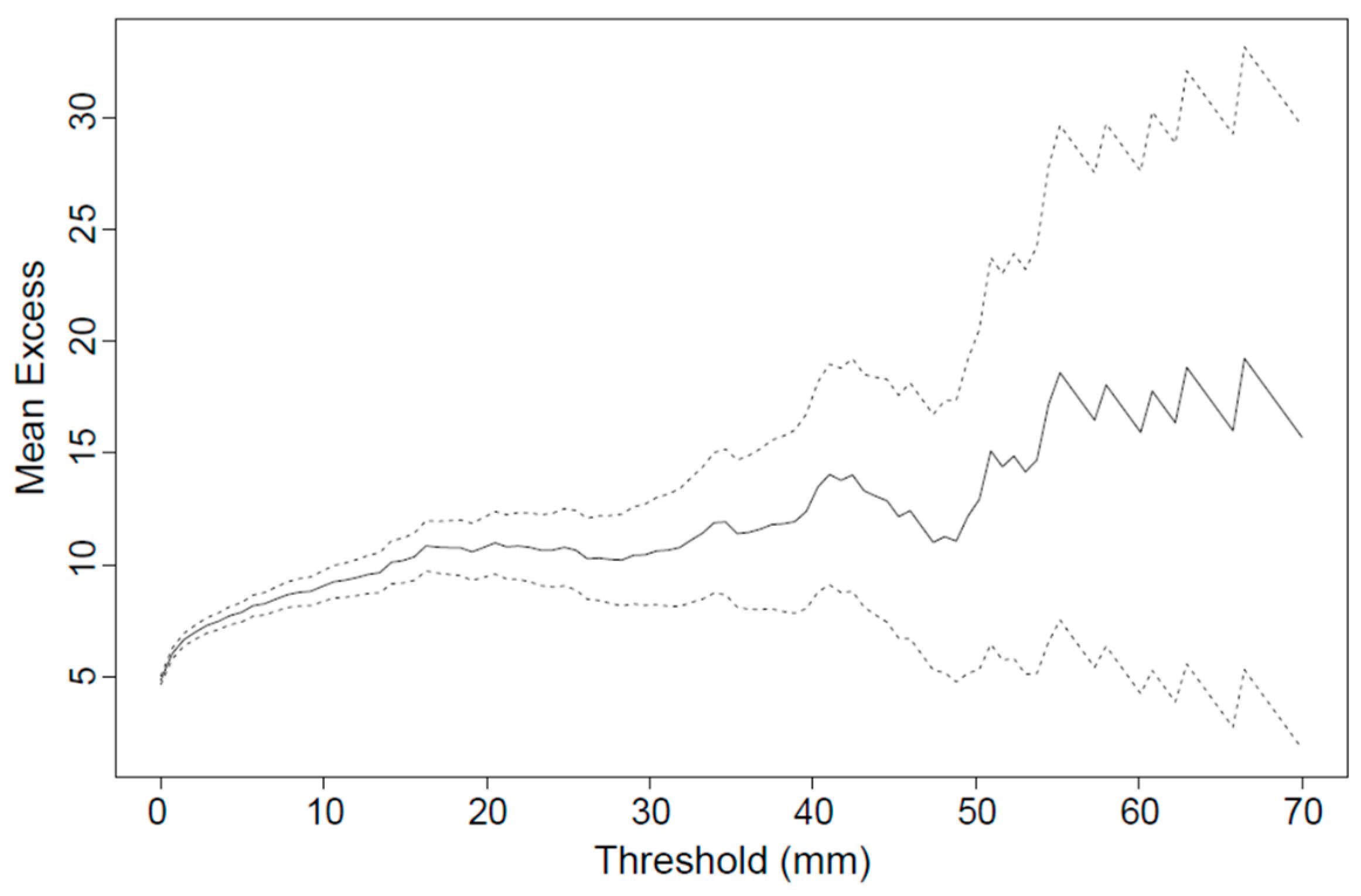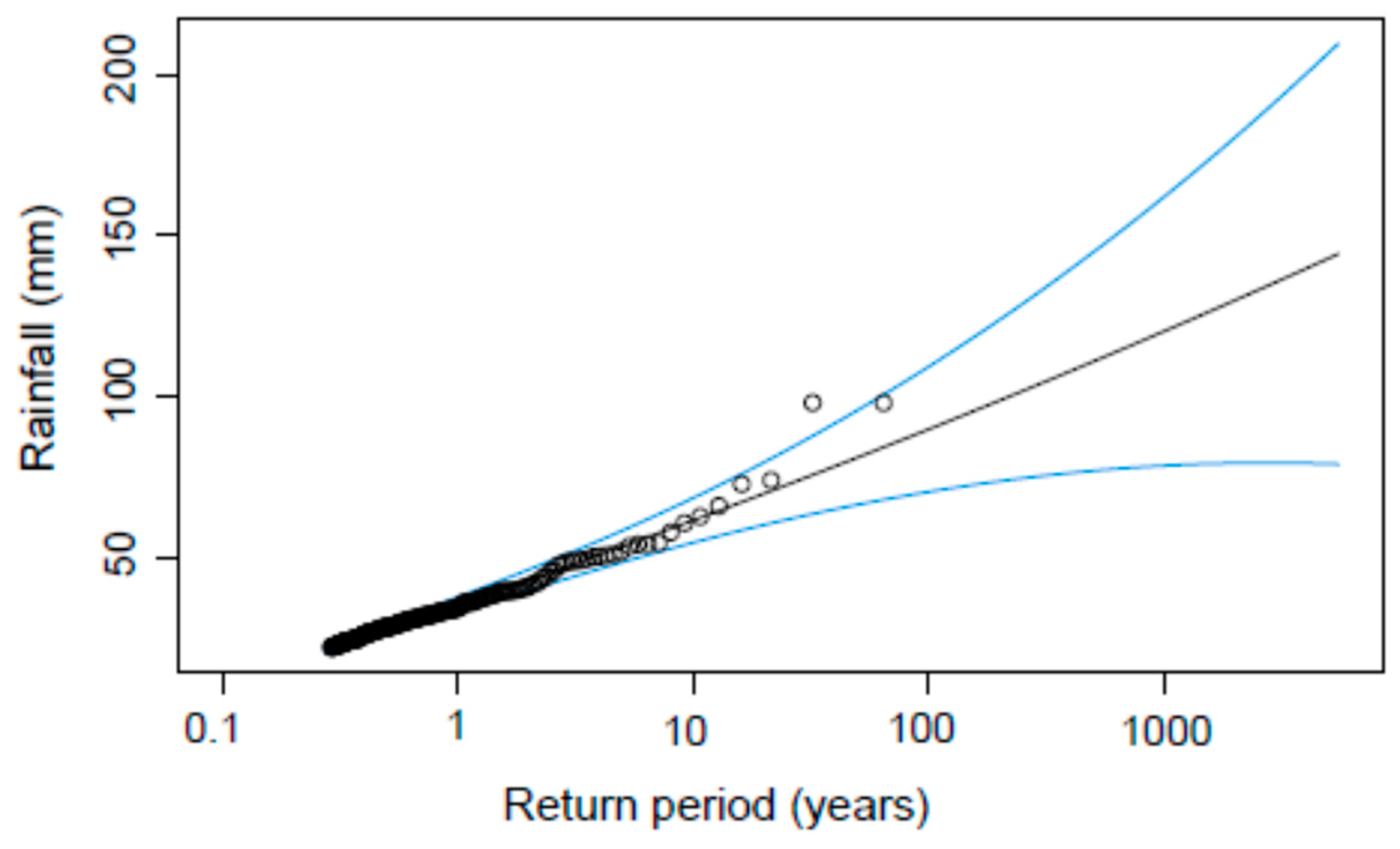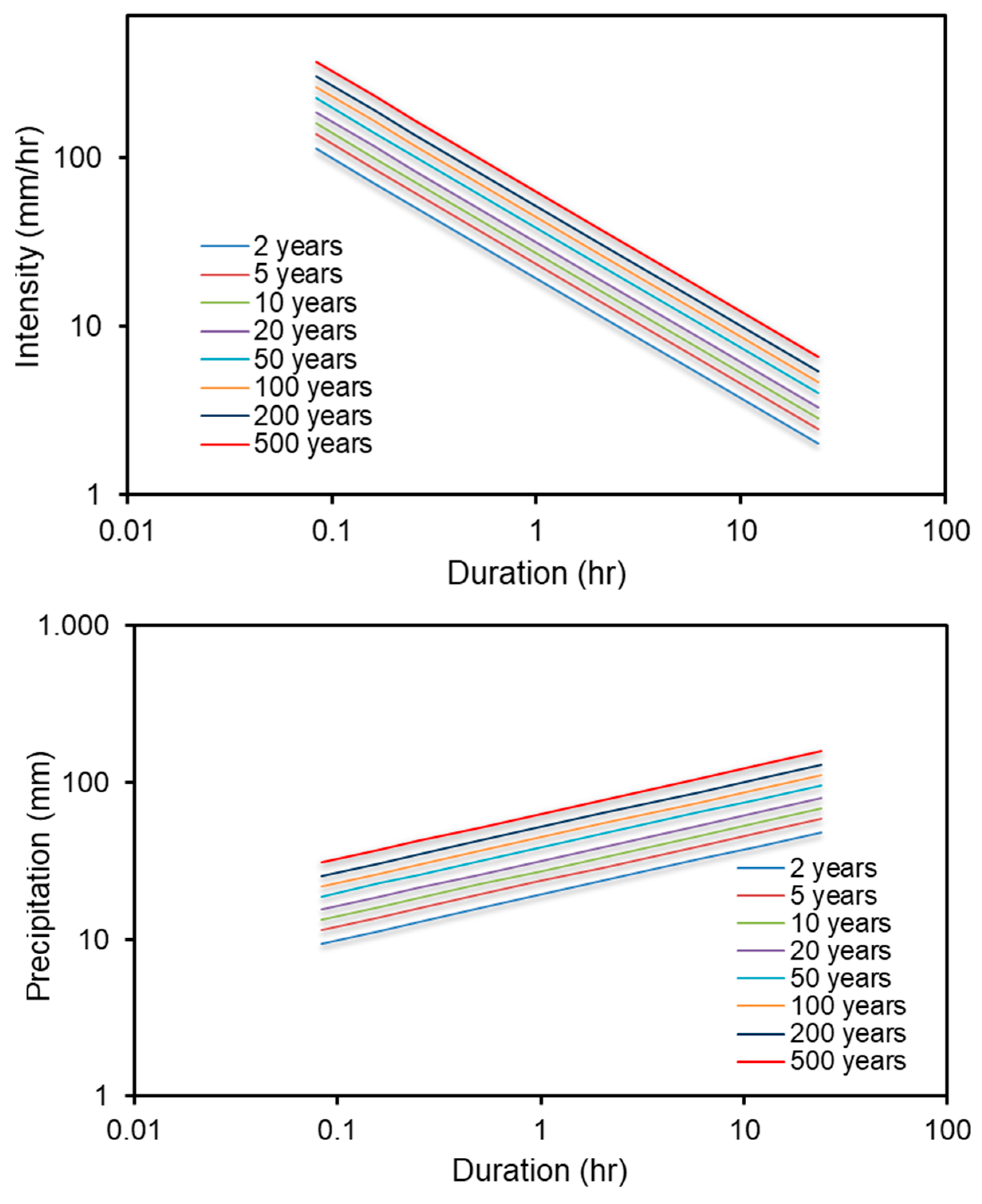Urban Flood Modelling under Extreme Rainfall Conditions for Building-Level Flood Exposure Analysis
Abstract
:1. Introduction
2. Materials and Methods
2.1. Study Area and Available Datasets
2.2. Extreme Rainfall Assessment
2.2.1. POT Threshold Selection
2.2.2. Scaling Rainfall Extremes
2.3. Flood Exposure
2.4. Modelling System and Model Set Up
3. Results
3.1. Extreme Rainfall Assessment
3.2. Modelled Flow Depth
3.3. Exposure Likelihood to Buildings
4. Conclusions
- Typical storm events have durations spanning 1 h to 2 h, so both durations have been used here to see how sensitive the damages are to storm duration. For storms of the same return period, a modest increase is found for the 2 h storm relative to the 1 h storm.
- The CityCAT model provides valuable insights into flood depths and water flowpaths, identifying a major water flowpath along Agias Sofias street, which is highly susceptible to flooding during intense rainfall events. The presence of small ponds in various parts of the studied catchment further highlights the potential for localised flooding.
- The estimated likelihood of flood exposure to buildings reveals the vulnerability of urban features to flood risk. Due to the previous flood events in the area, the number of buildings at high risk for both storm events underscores the importance of addressing flood impacts on the built environment.
- The modelling system is suitable for assessing the performance of flood-resilience strategies such as retention ponds, surface drainage improvements, and permeable pavements.
Author Contributions
Funding
Data Availability Statement
Acknowledgments
Conflicts of Interest
References
- Iliadis, C.; Glenis, V.; Kilsby, C. Representing buildings and urban features in hydrodynamic flood models. J. Flood Risk Manag. 2023; to be published. [Google Scholar]
- Ogden, F.L.; Pradhan, N.R.; Downer, C.W.; Zahner, J.A. Relative importance of impervious area, drainage density, width function, and subsurface storm drainage on flood runoff from an urbanized catchment. Water Resour. Res. 2011, 47, W12503. [Google Scholar] [CrossRef]
- Suriya, S.; Mudgal, B. Impact of urbanization on flooding: The Thirusoolam sub watershed—A case study. J. Hydrol. 2012, 412–413, 210–219. [Google Scholar] [CrossRef]
- Cabrera, J.S.; Lee, H.S. Flood-Prone Area Assessment Using GIS-Based Multi-Criteria Analysis: A Case Study in Davao Oriental, Philippines. Water 2019, 11, 2203. [Google Scholar] [CrossRef]
- Park, K.; Choi, S.-H.; Yu, I. Risk Type Analysis of Building on Urban Flood Damage. Water 2021, 13, 2505. [Google Scholar] [CrossRef]
- Teng, J.; Jakeman, A.J.; Vaze, J.; Croke, B.F.W.; Dutta, D.; Kim, S. Flood inundation modelling: A review of methods, recent advances and uncertainty analysis. Environ. Model. Softw. 2017, 90, 201–216. [Google Scholar] [CrossRef]
- Andjelkovic, I. Guidelines on Non-Structural Measures in Urban Flood Management; International Hydrological Programme (IHP), UNESCO: Paris, France, 2001. [Google Scholar]
- Willis, T.; Wright, N.; Sleigh, A. Systematic analysis of uncertainty in 2D flood inundation models. Environ. Model. Softw. 2019, 122, 104520. [Google Scholar] [CrossRef]
- Bellos, V.; Tsakiris, G. A hybrid method for flood simulation in small catchments combining hydrodynamic and hydrological techniques. J. Hydrol. 2016, 540, 331–339. [Google Scholar] [CrossRef]
- Hdeib, R.; Abdallah, C.; Colin, F.; Brocca, L.; Moussa, R. Constraining coupled hydrological-hydraulic flood model by past storm events and post-event measurements in data-sparse regions. J. Hydrol. 2018, 565, 160–176. [Google Scholar] [CrossRef]
- Papaioannou, G.; Efstratiadis, A.; Vasiliades, L.; Loukas, A.; Papalexiou, S.M.; Koukouvinos, A.; Tsoukalas, I.; Kossieris, P. An Operational Method for Flood Directive Implementation in Ungauged Urban Areas. Hydrology 2018, 5, 24. [Google Scholar] [CrossRef]
- Papaioannou, G.; Varlas, G.; Terti, G.; Papadopoulos, A.; Loukas, A.; Panagopoulos, Y.; Dimitriou, E. Flood Inundation Mapping at Ungauged Basins Using Coupled Hydrometeorological–Hydraulic Modelling: The Catastrophic Case of the 2006 Flash Flood in Volos City, Greece. Water 2019, 11, 2328. [Google Scholar] [CrossRef]
- Papaioannou, G.; Vasiliades, L.; Loukas, A.; Alamanos, A.; Efstratiadis, A.; Koukouvinos, A.; Tsoukalas, I.; Kossieris, P. A Flood Inundation Modeling Approach for Urban and Rural Areas in Lake and Large-Scale River Basins. Water 2021, 13, 1264. [Google Scholar] [CrossRef]
- Xafoulis, N.; Kontos, Y.; Farsirotou, E.; Kotsopoulos, S.; Perifanos, K.; Alamanis, N.; Dedousis, D.; Katsifarakis, K. Evaluation of Various Resolution DEMs in Flood Risk Assessment and Practical Rules for Flood Mapping in Data-Scarce Geospatial Areas: A Case Study in Thessaly, Greece. Hydrology 2023, 10, 91. [Google Scholar] [CrossRef]
- Alcrudo, F. Mathematical modelling techniques for flood propagation in urban areas. IMPACT Project technical report. 2004. [Google Scholar]
- McClean, F.; Dawson, R.; Kilsby, C. Implications of Using Global Digital Elevation Models for Flood Risk Analysis in Cities. Water Resour. Res. 2020, 56, e2020WR028241. [Google Scholar] [CrossRef]
- Zhu, S.; Dai, Q.; Zhao, B.; Shao, J. Assessment of Population Exposure to Urban Flood at the Building Scale. Water 2020, 12, 3253. [Google Scholar] [CrossRef]
- Stefanidis, S.; Alexandridis, V.; Theodoridou, T. Flood Exposure of Residential Areas and Infrastructure in Greece. Hydrology 2022, 9, 145. [Google Scholar] [CrossRef]
- Bertsch, R.; Glenis, V.; Kilsby, C. Building level flood exposure analysis using a hydrodynamic model. Environ. Model. Softw. 2022, 156, 105490. [Google Scholar] [CrossRef]
- Glenis, V.; Kutija, V.; Kilsby, C.G. A fully hydrodynamic urban flood modelling system representing buildings, green space and interventions. Environ. Model. Softw. 2018, 109, 272–292. [Google Scholar] [CrossRef]
- Iliadis, C.; Glenis, V.; Kilsby, C. A cost-benefit ‘source-receptor’ framework for implementation of Blue-Green flood risk management. J. Hydrol. 2023; under review. [Google Scholar]
- Bertsch, R.; Glenis, V.; Kilsby, C. Urban flood simulation using synthetic storm drain networks. Water 2017, 9, 925. [Google Scholar] [CrossRef]
- Rosenzweig, B.R.; Herreros Cantis, P.; Kim, Y.; Cohn, A.; Grove, K.; Brock, J.; Yesuf, J.; Mistry, P.; Welty, C.; McPhearson, T.; et al. The Value of Urban Flood Modeling. Earth’s Future 2021, 9, e2020EF001739. [Google Scholar] [CrossRef]
- Coles, S.; Bawa, J.; Trenner, L.; Dorazio, P. An Introduction to Statistical Modeling of Extreme Values; Springer: Berlin/Heidelberg, Germany, 2001; Volume 208. [Google Scholar]
- Mackay, E.; Jonathan, P. Assessment of return value estimates from stationary and non-stationary extreme value models. Ocean Eng. 2020, 207, 107406. [Google Scholar] [CrossRef]
- Northrop, P.J.; Coleman, C.L. Improved threshold diagnostic plots for extreme value analyses. Extremes 2014, 17, 289–303. [Google Scholar] [CrossRef]
- Galiatsatou, P.; Prinos, P. Bivariate analysis of extreme wave and storm surge events. Determining the failure area of structures. Open Ocean Eng. J. 2011, 4, 3–14. [Google Scholar] [CrossRef]
- Alonso, A.M.; de Zea Bermudez, P.; Scotto, M.G. Comparing generalized Pareto models fitted to extreme observations: An application to the largest temperatures in Spain. Stoch. Environ. Res. Risk Assess. 2014, 28, 1221–1233. [Google Scholar] [CrossRef]
- Radfar, S.; Galiatsatou, P. Influence of nonstationarity and dependence of extreme wave parameters on the reliability assessment of coastal structures—A case study. Ocean. Eng. 2023, 273, 113862. [Google Scholar] [CrossRef]
- Bader, B.; Yan, J.; Zhang, X. Automated threshold selection for extreme value analysis via ordered goodness-of-fit tests with adjustment for false discovery rate. Ann. Appl. Stat. 2018, 12, 310–329. [Google Scholar] [CrossRef]
- Silva Lomba, J.; Fraga Alves, M.I. L-moments for automatic threshold selection in extreme value analysis. Stoch. Environ. Res. Risk Assess. 2020, 34, 465–491. [Google Scholar] [CrossRef]
- G’Sell, M.G.; Wager, S.; Chouldechova, A.; Tibshirani, R. Sequential selection procedures and false discovery rate control. J. R. Stat. Soc. Ser. B Stat. Methodol. 2016, 78, 423–444. [Google Scholar] [CrossRef]
- Liu, J.; Wang, G.; Li, T.; Xue, H.; He, L. Sediment yield computation of the sandy and gritty area based on the digital watershed model. Sci. China Ser. E Technol. Sci. 2006, 49, 752–763. [Google Scholar] [CrossRef]
- Chen, G.F.; Qin, D.Y.; Ye, R.; Guo, Y.X.; Wang, H. A new method of rainfall temporal downscaling: A case study on sanmenxia station in the Yellow River Basin. Hydrol. Earth Syst. Sci. Discuss. 2011, 2011, 2323–2344. [Google Scholar]
- Chen, A.S.; Evans, B.; Djordjević, S.; Savić, D.A. A coarse-grid approach to representing building blockage effects in 2D urban flood modelling. J. Hydrol. 2012, 426–427, 1–16. [Google Scholar] [CrossRef]
- Koutsoyiannis, D.; Onof, C. Rainfall disaggregation using adjusting procedures on a Poisson cluster model. J. Hydrol. 2001, 246, 109–122. [Google Scholar] [CrossRef]
- Koutsoyiannis, D.; Onof, C.; Wheater, H.S. Multivariate rainfall disaggregation at a fine timescale. Water Resour. Res. 2003, 39, 1173. [Google Scholar] [CrossRef]
- Onof, C.; Townend, J.; Kee, R. Comparison of two hourly to 5-min rainfall disaggregators. Atmos. Res. 2005, 77, 176–187. [Google Scholar] [CrossRef]
- Marani, M.; Zanetti, S. Downscaling rainfall temporal variability. Water Resour. Res. 2007, 43, W09415. [Google Scholar] [CrossRef]
- Hanaish, I.S.; Ibrahim, K.; Jemain, A.A. Stochastic modeling of rainfall in Peninsular Malaysia using Bartlett Lewis rectangular pulses models. Model. Simul. Eng. 2011, 2011, 37. [Google Scholar]
- Lee, T.; Salas, J.D.; Prairie, J. An enhanced nonparametric streamflow disaggregation model with genetic algorithm. Water Resour. Res. 2010, 46, W08545. [Google Scholar] [CrossRef]
- Salas, J.D.; Lee, T. Nonparametric Simulation of Single-Site Seasonal Streamflows. J. Hydrol. Eng. 2010, 15, 284–296. [Google Scholar] [CrossRef]
- Lee, T.; Jeong, C. Nonparametric statistical temporal downscaling of daily precipitation to hourly precipitation and implications for climate change scenarios. J. Hydrol. 2014, 510, 182–196. [Google Scholar] [CrossRef]
- Kumar, J.; Brooks, B.-G.J.; Thornton, P.E.; Dietze, M.C. Sub-daily statistical downscaling of meteorological variables using neural networks. Procedia Comput. Sci. 2012, 9, 887–896. [Google Scholar] [CrossRef]
- Veneziano, D.; Lepore, C.; Langousis, A.; Furcolo, P. Marginal methods of intensity-duration-frequency estimation in scaling and nonscaling rainfall. Water Resour. Res. 2007, 43, W10418. [Google Scholar] [CrossRef]
- Bara, M.; Gaal, L.; Kohnova, S.; Szolgay, J.; Hlavčová, K. On the use of the simple scaling of heavy rainfall in a regional estimation of IDF curves in Slovakia. J. Hydrol. Hydromech. 2010, 58, 49–63. [Google Scholar] [CrossRef]
- Innocenti, S.; Mailhot, A.; Frigon, A. Simple scaling of extreme precipitation in North America. Hydrol. Earth Syst. Sci. 2017, 21, 5823–5846. [Google Scholar] [CrossRef]
- Galiatsatou, P.; Iliadis, C. Intensity-Duration-Frequency Curves at Ungauged Sites in a Changing Climate for Sustainable Stormwater Networks. Sustainability 2022, 14, 1229. [Google Scholar] [CrossRef]
- Galiatsatou, P.; Prinos, P. Modeling non-stationary extreme waves using a point process approach and wavelets. Stoch. Environ. Res. Risk Assess. 2011, 25, 165–183. [Google Scholar] [CrossRef]
- Bertsch, R. Exploring New Technologies for Simulation and Analysis of Urban Flooding. Ph.D. Thesis, Newcastle University, Newcastle upon Tyne, UK, 2019. [Google Scholar]
- Guo, K.; Guan, M.; Yu, D. Urban surface water flood modelling—A comprehensive review of current models and future challenges. Hydrol. Earth Syst. Sci. 2021, 25, 2843–2860. [Google Scholar] [CrossRef]
- Morales-Hernández, M.; Sharif, M.B.; Kalyanapu, A.; Ghafoor, S.K.; Dullo, T.T.; Gangrade, S.; Kao, S.C.; Norman, M.R.; Evans, K.J. TRITON: A Multi-GPU open source 2D hydrodynamic flood model. Environ. Model. Softw. 2021, 141, 105034. [Google Scholar] [CrossRef]
- Sanders, B.F. Hydrodynamic Modeling of Urban Flood Flows and Disaster Risk Reduction; Oxford University Press: Oxford, UK, 2017. [Google Scholar]
- Kilsby, C.; Glenis, V.; Bertsch, R. Coupled surface/sub-surface modelling to investigate the potential for blue-green infrastructure to deliver urban flood risk reduction benefits. In Blue-Green Cities: Integrating Urban Flood Risk Management with Green Infrastructure; Thorne, C., Ed.; ICE Publishing: London, UK, 2020; pp. 37–50. [Google Scholar]
- Warrick, A.W. Soil Water Dynamics; Oxford University Press: Oxford, UK; New York, NY, USA, 2003. [Google Scholar]
- Kjeldsen, T.R. The Revitalised FSR/FEH Rainfall-Runoff Method; Flood Estimation Handbook Supplementary Report No.1; Centre for Ecology & Hydrology: Crowmarsh Gifford, UK, 2007; pp. 1–64. [Google Scholar]














| Exposure Class | Mean Depth (m) | 90th Percentile (m) |
|---|---|---|
| Low | <0.10 | <0.30 |
| Medium | <0.10 | ≥0.30 |
| ≥0.10–<0.30 | <0.30 | |
| High | ≥0.10 | ≥0.30 |
| Return Period (Years) | 5 min–30 min | 30 min–24 h |
|---|---|---|
| 2 | 0.5415 | 0.7286 |
| 5 | 0.5674 | 0.7379 |
| 10 | 0.5908 | 0.7400 |
| 20 | 0.6136 | 0.7407 |
| 50 | 0.6418 | 0.7407 |
| 100 | 0.6614 | 0.7403 |
| 200 | 0.6794 | 0.7398 |
| 500 | 0.7008 | 0.7390 |
| Storm Scenarios | Medium | High |
|---|---|---|
| 50-year event with a duration of 1 h | 90 | 165 |
| 50-year event with a duration of 2 h | 99 | 186 |
Disclaimer/Publisher’s Note: The statements, opinions and data contained in all publications are solely those of the individual author(s) and contributor(s) and not of MDPI and/or the editor(s). MDPI and/or the editor(s) disclaim responsibility for any injury to people or property resulting from any ideas, methods, instructions or products referred to in the content. |
© 2023 by the authors. Licensee MDPI, Basel, Switzerland. This article is an open access article distributed under the terms and conditions of the Creative Commons Attribution (CC BY) license (https://creativecommons.org/licenses/by/4.0/).
Share and Cite
Iliadis, C.; Galiatsatou, P.; Glenis, V.; Prinos, P.; Kilsby, C. Urban Flood Modelling under Extreme Rainfall Conditions for Building-Level Flood Exposure Analysis. Hydrology 2023, 10, 172. https://doi.org/10.3390/hydrology10080172
Iliadis C, Galiatsatou P, Glenis V, Prinos P, Kilsby C. Urban Flood Modelling under Extreme Rainfall Conditions for Building-Level Flood Exposure Analysis. Hydrology. 2023; 10(8):172. https://doi.org/10.3390/hydrology10080172
Chicago/Turabian StyleIliadis, Christos, Panagiota Galiatsatou, Vassilis Glenis, Panagiotis Prinos, and Chris Kilsby. 2023. "Urban Flood Modelling under Extreme Rainfall Conditions for Building-Level Flood Exposure Analysis" Hydrology 10, no. 8: 172. https://doi.org/10.3390/hydrology10080172
APA StyleIliadis, C., Galiatsatou, P., Glenis, V., Prinos, P., & Kilsby, C. (2023). Urban Flood Modelling under Extreme Rainfall Conditions for Building-Level Flood Exposure Analysis. Hydrology, 10(8), 172. https://doi.org/10.3390/hydrology10080172










